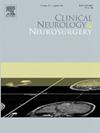Clinical risk factors for mortality in low severity acute epidural hematoma
IF 1.8
4区 医学
Q3 CLINICAL NEUROLOGY
引用次数: 0
Abstract
Background
Epidural hematomas (EDH) pose life-threatening risks with considerable morbidity and mortality if left untreated. The prognosis for patients with low-severity acute EDH managed conservatively is variable, with limited understanding of risk factors. This study aims to identify clinical risk factors for mortality in low-severity acute epidural hematoma patients managed conservatively, helping clinicians recognize cases where deviation from conservative management may be necessary.
Methods
The National Trauma Data Bank was queried from 2017 to 2019 for all patients with EDH with a Glasgow Coma Scale score greater than or equal to 13 who were non-surgically treated. A multivariable logistic regression (MLR) was performed to identify risk factors associated with mortality in this patient group (Alpha=0.05).
Results
The MLR included 12,634 patients who survived and 245 patients who died during their hospital stay. Older age (OR=1.056, 95 % CI: 1.047–1.065), congestive heart failure (OR=1.708, 95 % CI: 1.079–2.705), chronic renal failure (OR=2.727, CI: 1.577–4.713), anticoagulant therapy (OR=1.428, 95 % CI: 1.019–2.001), and cirrhosis (OR=3.027, 95 % CI: 1.436–6.380)) were associated with increased odds of mortality.
Conclusion
Among patients that present with a low-severity acute EDH who were treated non-surgically, this study indicates that risk factors for mortality include older age, congestive heart failure, chronic renal failure, anticoagulant therapy, and cirrhosis. Our findings highlight comorbidities that significantly increase mortality risk, underscoring the need for increased vigilance and consideration of surgical intervention in patients meeting these criteria, even when conservative management is initially pursued. Further research is warranted to determine how to mitigate the mortality risk in these patients.
求助全文
约1分钟内获得全文
求助全文
来源期刊

Clinical Neurology and Neurosurgery
医学-临床神经学
CiteScore
3.70
自引率
5.30%
发文量
358
审稿时长
46 days
期刊介绍:
Clinical Neurology and Neurosurgery is devoted to publishing papers and reports on the clinical aspects of neurology and neurosurgery. It is an international forum for papers of high scientific standard that are of interest to Neurologists and Neurosurgeons world-wide.
 求助内容:
求助内容: 应助结果提醒方式:
应助结果提醒方式:


